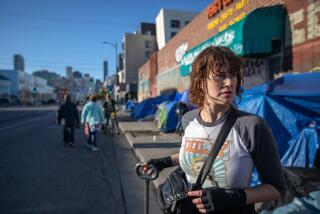CHOC Gets in Gear With Home Safety
- Share via
Hospitals are places you go when seriously injured. But who would argue that the hospital has a responsibility to help keep you healthy?
Maybe Children’s Hospital of Orange County takes on that task because so many of its patients wind up there from tragic circumstances. Children 5 and younger get hurt not because they’re careless, but because we are careless. We adults.
More youngsters in this age group die each year from injuries than from disease--nearly 7,000 annually in the United States, according to the National Safe Kids Campaign. And another 14 million children are injured seriously enough each year to require medical attention.
Where do all of these injuries occur? Nearly 5 million of them right in our homes.
Now comes the latest CHOC weapon to help us make our homes safer for children: a 38-foot-long, four-room home on wheels we can tour so experts can show us how these injuries happen.
“At least 90% of all injuries to children are preventable,” said Juliette Moehn, a CHOC community educator who has helped plan this mobile unit.
It hasn’t been a minor job. First the Orange-based hospital had to come up with $400,000 in donations just to get it built. Then CHOC’s community education program spent months trying to figure out how to make sure we wouldn’t just take a tour, say, “That’s nice” and go back to our old habits.
So here’s its game plan:
After it’s completed next month, the mobile unit will start rolling out to community centers, health fairs, anywhere adults who supervise children gather.
Before entering, visitors will be tested to see how much they know about household dangers for small children. Once aboard, they will be given a checklist they can take to survey their own homes. Monitors in each room will allow them to see videos showing how injuries happen. Before visitors leave, they’ll also get a resource packet with detailed information about household injuries.
Once outside, visitors will be able to buy safety devices, including gates and locks, at discounted prices. A staff member will even be on hand to demonstrate how they work, for people like me, who barely know a screwdriver from a wrench.
My colleague Brady MacDonald and I recently toured the mobile home at Exhibit Works in Foothill Ranch, where it was designed. I suggested to Moehn that it would be worth the effort if people left the tour at least more sensitive to danger spots in their home.
Not enough, she said. “We don’t want to just raise people’s awareness,” she said. “We want people to leave here with the tools so that they can take action.”
Here’s what CHOC says we can prevent: falls, burns, scaldings, electrocutions, poisoning, choking, drowning and strangulations.
Most of what’s demonstrated may seem like common sense.
Let’s see a show of hands: How many think it’s OK to leave household poisons, like bug killer or floor cleaners, within reach of infants and toddlers? Yet we slip without thinking. CHOC’s corridors are filled with youngsters whose parents or grandparents thought they had everything out of reach.
Moehn even talks about “purse poisonings.” Someone comes to visit, puts a purse on a chair, and while the adults chat, the youngster explores, ingesting the visitor’s cold medicine. Hey, it happens. All of this education is based on real-life experiences.
Here’s an injury maybe few of us give thought to: How protected is your child from the house’s water heater? Because we love steaming showers, many of us set our water heaters too high: 120 degrees Fahrenheit is the highest safe level.
The mobile unit features a living room, kitchen, bathroom and child’s room. You can even learn where--and where not--to change a diaper.
Moehn emphasizes that although entire families will tour the mobile unit, it isn’t meant for teaching children.
“We want to reach parents, grandparents, baby-sitters, anybody who is a care provider,” she said. “They are the ones who control children’s environments.”
The question that remains: Will it work? Will we tour the place, listen to the experts’ spiel and then ignore the advice because we get too busy with other things?
One stop on the mobile unit tour is the medicine cabinet. I was reminded that a few months ago, after a column on the dangers of keeping expired medicines, I promised readers I was about to clean mine out. I haven’t gotten to it yet.
But CHOC is convinced this school-on-wheels will make a difference. It has committed a $500,000 annual budget to keep it operating. And once you’ve left its doors, CHOC plans to mail you follow-ups, friendly but firm home safety reminders. (Still haven’t changed those smoke detector batteries?)
The National Safe Kids Campaign says so many children are injured at home because home is where most of them spend the vast majority of their time.
It’s one place that can be their haven. If we make it that way.
*
Jerry Hicks’ column appears Monday and Thursday. Readers may reach Hicks by calling (714) 966-7789 or e-mail to jerry.hicks@latimes.com.
(BEGIN TEXT OF INFOBOX / INFOGRAPHIC)
Traveling Safe House
Children’s Hospital of Orange County staff will use a new mobile trailer safety house to educate parents about the dangers around the home to young children.
TRAILER has four rooms, two pop-out areas and multiple educational video monitors.
TRUCK can haul 17,000 pounds.
Source: Children’s Hospital of Orange County, Exhibit Works
More to Read
Sign up for Essential California
The most important California stories and recommendations in your inbox every morning.
You may occasionally receive promotional content from the Los Angeles Times.













